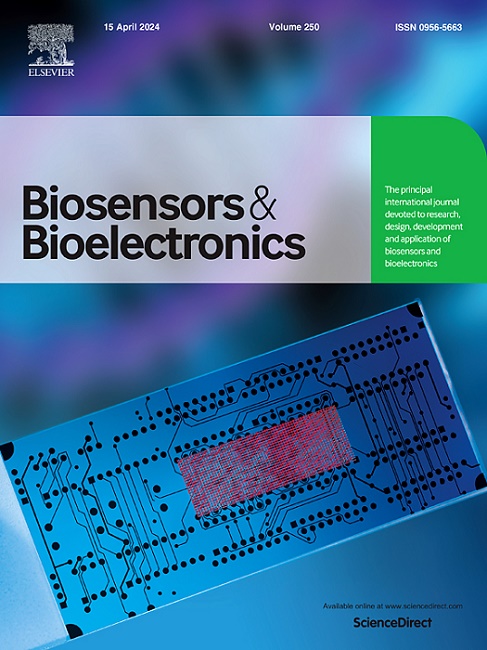智能响应水凝胶在核酸和基于核酸的目标传感中的应用:综述
IF 10.7
1区 生物学
Q1 BIOPHYSICS
引用次数: 0
摘要
近年来,与核酸有关的传感和检测已成为临床诊断、治疗和基因分型的关键,特别是在人类基因组计划和 COVID-19 大流行病方面。分析化学中采用了许多传统的核酸相关传感策略,包括荧光、比色和化学发光方法。然而,这些方法的主要局限是缺乏对分析过程中相互作用的了解,尤其是在接近生物组织的三维基质层面。为了解决这个问题,智能响应水凝胶因其亲水性和生物相容性,越来越多地被用于生物传感。通过将智能响应水凝胶与传统的核酸相关传感技术相结合,可以模拟生物微环境,使目标物易于接触和扩散,从而使其成为核酸传感的理想选择。本综述重点介绍利用智能响应水凝胶进行核酸相关传感和检测,包括核酸检测、其他基于核酸的分析物检测以及在水凝胶中应用核酸作为传感工具的核酸相关传感平台。此外,还介绍了智能响应水凝胶与光学和电化学技术等各种检测平台相结合的分析机制。还讨论了在核酸相关传感中使用智能响应水凝胶的局限性,并提出了可能的解决方案。最后,探讨了智能响应水凝胶在核酸相关传感中的未来挑战。智能响应水凝胶可用作模拟细胞外基质的仿生材料,实现生物传感,在核酸相关传感方面具有巨大潜力。它们是传统检测和分析方法的重要补充。本文章由计算机程序翻译,如有差异,请以英文原文为准。

Application of smart-responsive hydrogels in nucleic acid and nucleic acid-based target sensing: A review
In recent years, nucleic acid-related sensing and detection have become essential in clinical diagnostics, treatment and genotyping, especially in connection with the Human Genome Project and the COVID-19 pandemic. Many traditional nucleic acid-related sensing strategies have been employed in analytical chemistry, including fluorescence, colorimetric and chemiluminescence methods. However, their key limitation is the lack of understanding of the interaction during analysis, particularly at the 3D matrix level close to biological tissue. To address this issue, smart-responsive hydrogels are increasingly used in biosensing due to their hydrophilic and biocompatible properties. By combining smart-responsive hydrogels with traditional nucleic acid-related sensing, biological microenvironments can be mimicked, and targets can be easily accessed and diffused, making them ideal for nucleic acid sensing. This review focuses on utilizing smart-responsive hydrogels for nucleic acid-related sensing and detection, including nucleic acid detection, other nucleic acid-based analyte detection and nucleic acid-related sensing platforms applying nucleic acid as sensing tools in hydrogels. Additionally, the analytical mechanisms of smart-responsive hydrogels with the combination of various detection platforms such as optical and electrochemical techniques are described. The limitations of using smart-responsive hydrogels in nucleic acid-related sensing and proposed possible solutions are also discussed. Lastly, the future challenge of smart-responsive hydrogels in nucleic acid-related sensing is explored. Smart-responsive hydrogels can be used as biomimetic materials to simulate the extracellular matrix, achieve biosensing, and exhibit great potential in nucleic acid-related sensing. They serve as a valuable complement to traditional detection and analytical methods.
求助全文
通过发布文献求助,成功后即可免费获取论文全文。
去求助
来源期刊

Biosensors and Bioelectronics
工程技术-电化学
CiteScore
20.80
自引率
7.10%
发文量
1006
审稿时长
29 days
期刊介绍:
Biosensors & Bioelectronics, along with its open access companion journal Biosensors & Bioelectronics: X, is the leading international publication in the field of biosensors and bioelectronics. It covers research, design, development, and application of biosensors, which are analytical devices incorporating biological materials with physicochemical transducers. These devices, including sensors, DNA chips, electronic noses, and lab-on-a-chip, produce digital signals proportional to specific analytes. Examples include immunosensors and enzyme-based biosensors, applied in various fields such as medicine, environmental monitoring, and food industry. The journal also focuses on molecular and supramolecular structures for enhancing device performance.
 求助内容:
求助内容: 应助结果提醒方式:
应助结果提醒方式:


